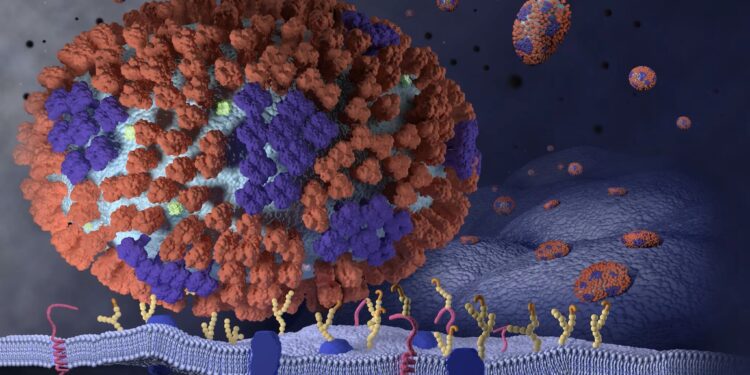This image illustrates the very early stages of an influenza (flu) infection in the respiratory tract. Credit: CDC
Scientists have long viewed the fluid-filled sac around our lungs as simply a cushion against external damage. It turns out it also harbors potent virus-eating cells that rush into the lungs during flu infections.
Not to be confused with phages, which are viruses that infect bacteria, these cells are macrophages, immune cells produced in the body.
“The name macrophage means “big eater”. “They gobble up bacteria, viruses, cancer cells and dying cells. Really, anything that seems foreign, they absorb and destroy it,” said Juliet Morrison, a virologist at UC Riverside, who led the discovery team. “We were surprised to find them in the lungs because no one had seen this before, that these cells get into the lungs when there is an infection.”
An article published in the Proceedings of the National Academy of Sciences details how, during influenza infection, macrophages leave the outer cavity and enter the lungs where they decrease inflammation and reduce disease levels.
“This study shows that what matters is not just what happens in the lungs, but also what happens outside the lungs. Cell types that are not normally connected to the lungs may have impacts disproportionate on lung disease and health,” Morrison said.
There are three main cavities in the body: one around the heart, the abdominal cavity, and the pleural cavity surrounding the lungs. “Because it contains fluid, it prevents the lungs from collapsing. However, people have not given much thought to the fact that the pleural cavity is an organ in its own right. This research could change that perception,” he said. Morrison said.
First, the researchers sought to understand the more general question of what types of cells are present in the lungs during influenza infections. They took existing data on lung-related genes from studies of mice that died from the flu or survived. They then extracted the data using an algorithm to predict the types of cells that change in the lungs during infections.
“We took massive data and broke it down to determine what potential immune cells are in the lung tissue. That’s where I got the idea that maybe we had an external source of cells in the lungs previously unknown,” Morrison said.
Then, using a laser technique, the team tracked the macrophages entering the lungs of mice and observed what happened if these cells were removed from the equation. “When you take them out of the mouse, you see more lung disease and inflammation,” Morrison said.
Morrison says she hopes this study will encourage other scientists to reevaluate data sets from older studies. “Our approach was to take information that was already available and use it again, and we were able to see something new,” she said.
In the future, the research team hopes to determine which proteins “signal” macrophages to move to the lungs. Once the protein signals are identified, it may be possible to create drugs that would increase either the number of macrophages or their activity.
The strategy of boosting human defenses against infection, rather than developing another antiviral, could offer people a flu treatment that would be more effective for much longer. Morrison became interested in host therapies because resistance to antibiotics and antivirals is a growing problem.
This problem occurs when germs like bacteria and fungi develop the ability to defeat medications designed to kill them. Drug abuse and overuse accelerate the problem. According to the Centers for Disease Control and Prevention, more than 2.8 million drug-resistant infections occur each year in the United States, resulting in the deaths of more than 35,000 people.
“If we can strengthen what resolves the infection within us, we’ll probably have a better chance. We’re less likely to have resistance. The immune system is very complex, but it’s our best long-term bet to work with what we have rather than chasing viruses that continue to evade our treatments,” Morrison said.
More information:
Pleural macrophages move to the lungs during infection to promote better influenza outcomes, Proceedings of the National Academy of Sciences (2024). DOI: 10.1073/pnas.230047412
Provided by University of California – Riverside
Quote: Scientists discover hidden army of lung flu fighters (February 14, 2024) retrieved February 14, 2024 from
This document is subject to copyright. Apart from fair use for private study or research purposes, no part may be reproduced without written permission. The content is provided for information only.



